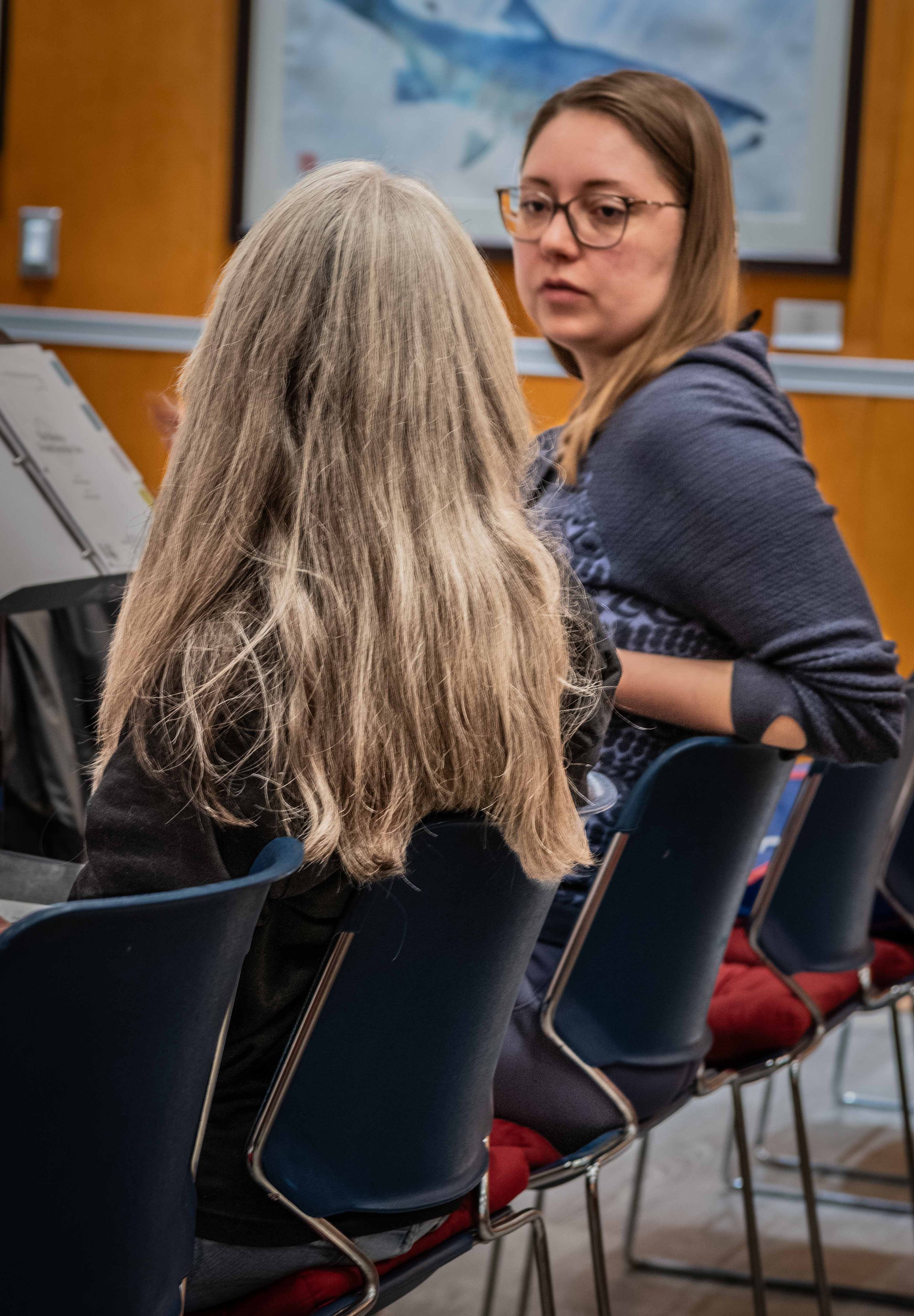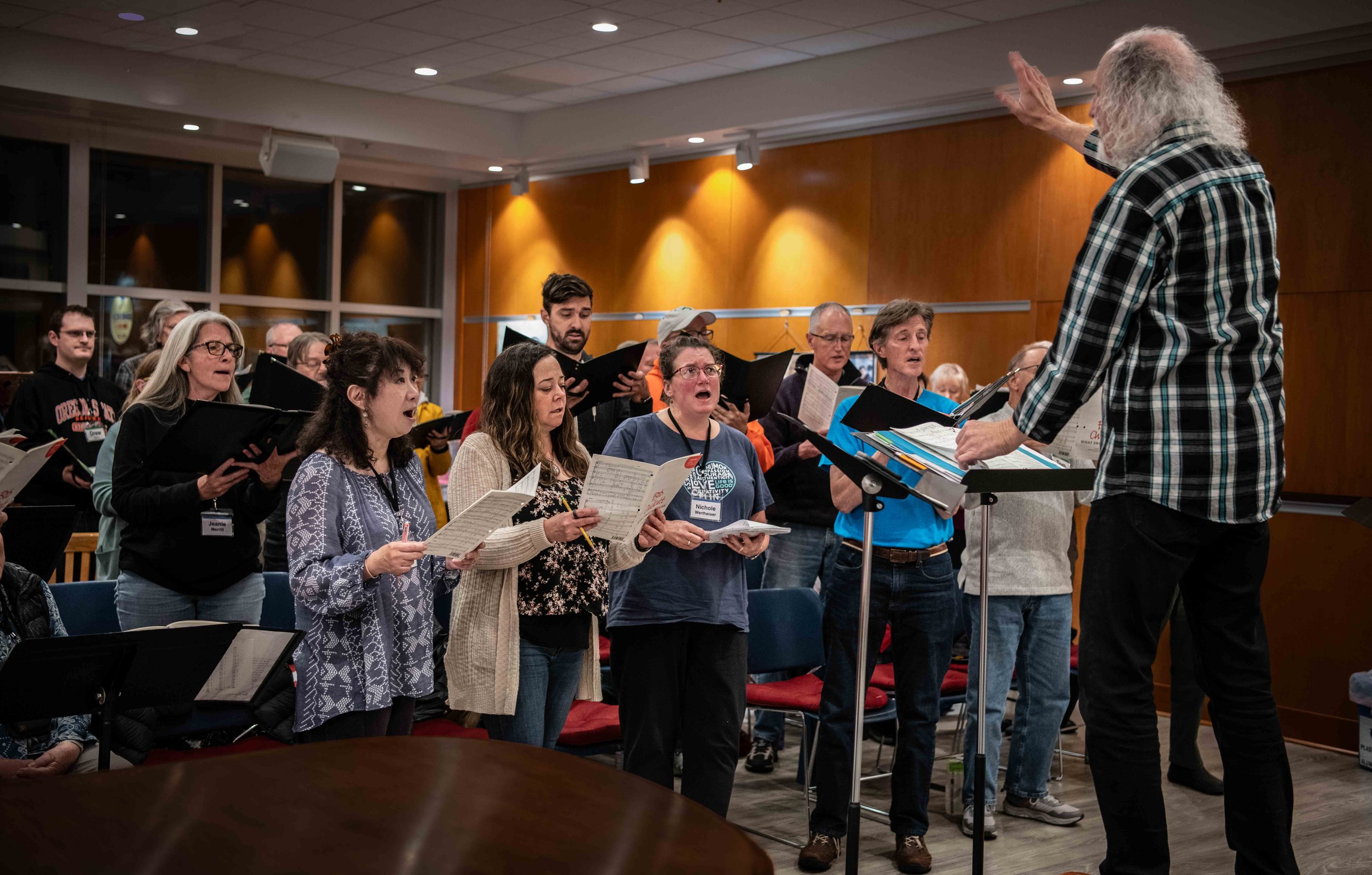How to build a concert: Winter 2023
Where does Artistic Director Rhodd Caldwell start? With music of course. For this series of concerts (Winter 2023 & Spring 2024) Rhodd has decided to use the library amassed by Central Coast Chorale (CCC)—now Coastal Voices (CV)--over the 25-year span of the organization. Dr. Mary Lee Scoville started building the library in 1998 when she and a few others first decided to form a local singing ensemble. What a good idea that was! Now Rhodd and the 54-voice CV can benefit from her musical vision and knowledge as they choose favorites from that collection of choral pieces. Rhodd asked several long-time chorus members to list their favorites from past CCC and CV recitals. Taking their suggestions and melding them with his own vision for the Holiday Highlights concert, Rhodd created a program of music that honors Kwanzaa, Solstice, Chanukah and Christmas.
Rhodd directs one of his selections.
Longtime choir member Karin Bigler, (front left) shown with other sopranos, was one of the singers Rhodd consulted as he built the song list.
Once the music is chosen, it must be transferred to a format that will allow the choir members to practice on their own between rehearsal sessions. Accompanist extraordinaire Milo Gramaans records all the separate parts plus an all-voices version, for all the songs. He then transfers the digital files to Tom Heimburger and Steven Kacsmer who (magically) put them on the website for members to download as needed.
Milo’s hands at work.
Now the sheet music is handed out to the singers and the work begins! Rhodd assigns song measures for learning each week. During the first half of a rehearsal, the choir divides into sectionals for practice on the designated areas. Thus the sopranos work on their problem spots, which are not the same tricky bits as the altos are singing; the tenors perfect their notes and timing while the basses learn the foundational low tones of each song. Then it is time for a break and some relaxing conversation and fun.
Only ten minutes for a quick laugh and conversation.
Putting it together consumes the second half of a rehearsal. This is the time when Rhodd becomes our best critic. Pronunciation is so important: “shine-nah” “light-teh” “and-dah.” Fitting the words to the rhythm: “Let’s speak the lyrics while I count out the time.” “Again.” “Again!”
The maestro perfecting timing and diction.
The accompanist must play the same parts over and over while the choir tries to meet the standards Rhodd is setting. Milo is ever ready with a first pitch or a run-through of a single part or playing two parts together or delineating a tricky rhythm section. He adds the full piano accompaniment upon request—-sometimes in the middle of a page.
Play that again Milo please…
Could we hear that again Milo please?
Start at measure 46 please Milo.
Just the tenors Milo please.
Basses and sopranos at 73 Milo…thank you
Milo—play the alto part measures 44-53 please
Play the full accompaniment from the beginning please Milo
Along with notes and pronunciation, each song has specific dynamics that are integral to the meaning of the piece. The singers have to keep track of any changes that Rhodd may make to the original score. Softer here because there are so many sopranos and altos. Louder there to emphasize a particular lyric. One song ends with a full blast of voices that Rhodd summons with full body calisthenics. Another selection fades away into silence following Rhodd’s quiet hand motions. Each singer turns each piece of music into a visual aid using colored markers or coded pencil squiggles or other methods that have secret meanings.
Watching the director is the final imperative. “Hold your music up so that you can see me over it!” Rhodd commands. He also reminds the choir that the audience has not paid admission in order to see the tops of everyone’s heads.
So now the choir can sing a song all the way through to the end? Depends. And eventually. All the work that seems to arbitrarily stop and go will result in a polished performance with articulated lyrics, balanced tuned voices, modulated dynamics, and full sound from a group of singers who are facing and singing to the audience. This is Rhodd’s ambition. The choir is his instrument.
A chorus at work.
One more time.
“Well done. Go in peace.”
















